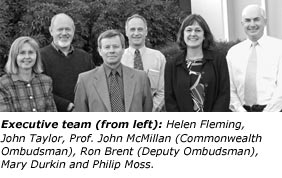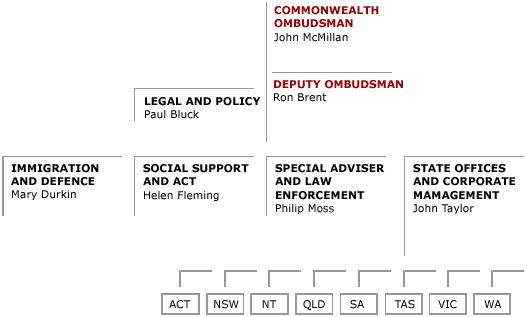Commonwealth Ombudsman Annual Report 2003-04 | Chapter 2
![]()
CHAPTER 2 | about us
History and establishment
The office of the Commonwealth Ombudsman was established by the Ombudsman Act 1976 (Ombudsman Act), and is administered by the Prime Minister. In 1971, the Commonwealth Administrative Review Committee issued a report recommending that an Ombudsman office be established. The Committee proposed a new and distinctive system of administrative law in Australia. It envisioned that the Ombudsman would play a part, along with courts and administrative tribunals, in examining government administrative action.
The office commenced operation on 1 July 1977. Since then, seven Commonwealth Ombudsman have been in office. Over time, the responsibilities of the Ombudsman have expanded to cover:
- complaints about Australian Federal Police (AFP)—1981
- complaints about Freedom of Information—1982
- Defence Force Ombudsman role—1983
- responsibility for compliance auditing of AFP and National Crime Authority (now Australian Crime Commission) telecommunication intercept records—1988, with added responsibilities for monitoring controlled operations in 2001
- Australian Capital Territory Ombudsman—1989
- Special Tax Adviser function created—1995
- Postal Industry Ombudsman responsibilities to be added in 2004–05.
Role and functions
The Commonwealth Ombudsman has two major statutory roles; both aim to safeguard the rights of people who deal with Australian Government agencies. These roles are:
- the investigation and review of administrative actions of Australian Government officials and agencies by investigating complaints from individuals, groups or organisations
- 'own motion' or 'own initiative' investigations by undertaking investigations of Commonwealth administrative actions—that is, on the initiative of the Ombudsman—often arising from the insight gained from handling individual complaints.
In either case, the Ombudsman can recommend that corrective action be taken by an agency. This occurs either specifically in an individual case or generally by a change to relevant legislation, administrative policies or procedures.
'A key objective of the Ombudsman is to foster good public administration within Australian Government agencies …'
The guiding principle in an Ombudsman investigation is whether the administrative action under investigation is unlawful, unreasonable, unjust, oppressive, improperly discriminatory, factually deficient, or otherwise wrong.
In other words, Ombudsman investigations are based on assessing whether there has been defective administration. A key objective of the Ombudsman is to foster good public administration within Australian Government agencies, ensuring that the principles and practices of public administration are sensitive, responsive and adaptive to the interests of members of the public.
The Ombudsman Act confers two specialist roles on the Ombudsman:
- Defence Force Ombudsman—handling grievances lodged by serving and former members of the Australian Defence Force
- Taxation Ombudsman—handling complaints about the Australian Taxation Office.
AFP
Under the Complaints (Australian Federal Police) Act 1981, the Commonwealth Ombudsman and the AFP are jointly responsible for managing complaints about AFP members. These members may be employed in international, national and ACT community policing duties.
ACT Ombudsman
The Commonwealth Ombudsman also performs the role of ACT Ombudsman under the Ombudsman Act 1989 (ACT) in accordance with a Memorandum of Understanding between the Ombudsman and the ACT Government. The Ombudsman submits an annual report to the ACT Legislative Assembly on the performance of the ACT Ombudsman function.
Values
The key values of the Commonwealth Ombudsman are:
- independence
- impartiality
- integrity
- accessibility
- professionalism
- teamwork.
Organisation and structure
 The National Office of the Commonwealth Ombudsman
and the office of the ACT Ombudsman are co-located in Canberra. The Commonwealth Ombudsman also has offices in Adelaide, Brisbane, Darwin, Hobart, Melbourne, Perth and Sydney.
The National Office of the Commonwealth Ombudsman
and the office of the ACT Ombudsman are co-located in Canberra. The Commonwealth Ombudsman also has offices in Adelaide, Brisbane, Darwin, Hobart, Melbourne, Perth and Sydney.
The Ombudsman and Deputy Ombudsman are statutory officers appointed under the Ombudsman Act 1976. Staff are employed under the Public Service Act 1999.
The office comprises a range of functional elements:
- Central office functions and responsibilities (including human resources, information technology, financial services, records management and public relations) and the principal specialist teams are based in the National Office in Canberra.
- Offices throughout Australia handle complaints and undertake some specialist work. Complaint handling relating to the ACT Ombudsman function is performed in Canberra. A Senior Assistant Ombudsman, located in Melbourne, supervises the Adelaide, Brisbane, Darwin, Hobart, Melbourne, Perth and Sydney offices, as well as other corporate functions.
Three Senior Assistant Ombudsman manage the specialist teams located in the National Office:
- ACT Regional Team—dual role in complaint handling relating to Australian Government and ACT Government departments and agencies.
- Defence Team—specialised advice and complaint handling relating to the Australian Defence Force and Department of Veterans' Affairs, also specialising in Customs, Comcare and Comsuper complaints.
- Immigration Team—specialised advice and complaint handling relating to the Department of Immigration and Multicultural and Indigenous Affairs.
- Law Enforcement Team—complaint handling, monitoring and investigation of law enforcement activities relating to Australian Government law enforcement agencies.
- Social Support Team—specialised advice and complaint handling relating to the Department of Family and Community Services, Centrelink, and the Child Support Agency.
- Taxation Team—specialised advice and complaint handling relating to the Australian Taxation Office, under the supervision of the Ombudsman's Special Tax Adviser.
Chart 1 illustrates the organisational structure of the Ombudsman's office. This annual report contains feature pages of the specialist teams.
CHART 1Commonwealth Ombudsman organisational structure, 2003–04

Outcome and output structure
Our 2003–04 strategic plan provides broad direction for our work, and the 2003–04 Portfolio Budget Statements define one central outcome for the office, supported by two outputs.
The central outcome is to achieve equitable resolution of complaints from the public and foster improved and fair administration by Australian Government agencies. The supporting outputs are the:
- provision of a complaint management service for government
- provision of advice to government to improve public administration.
Details of the Commonwealth Ombudsman's achievement of the outcome and outputs are in the Performance Report chapter.
Strategic plan
The major objectives outlined in the office's 2003–04 strategic plan are to:
- investigate complaints against Australian Government agencies and make recommendations for resolving complaints
- foster good complaint handling in Australian Government agencies
- encourage and assist people to resolve problems directly with government agencies
- highlight problems in public administration through complaint handling, own motion investigations and reporting
- focus attention on the adverse impact government administration can have on individuals
- promote open government
- inspect the accuracy and comprehensiveness of law enforcement records, including telephone interceptions and controlled operations
- provide assistance to Ombudsman offices in the Asia–Pacific region.
Business plans
Each specialist team and office throughout Australia has developed a detailed business plan outlining strategies and activities to support the strategic plan. The plans are customised to reflect current challenges and relevant issues facing individual teams. These business plans are, in turn, used to develop individual work plans for staff members.
The strategic plan for the office is being reviewed, and business plans are being developed for 2004–05.
